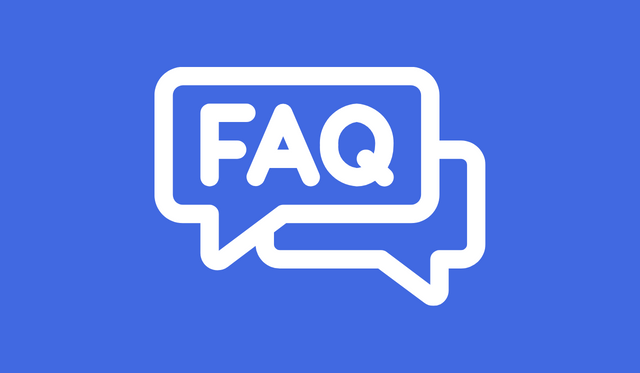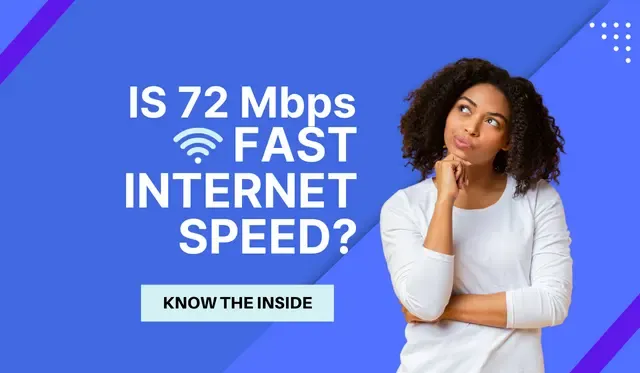going to show you. According to a recent study, the average household has an
internet connection that is only capable of downloading at a rate of up to
72 Mbps. So, 72 Mbps Is Fast Enough Internet Speed?
72 Mbps Speed Means:
Mbps speed, you can expect to download a file that is about 8.9 MB in size
in about 10 seconds.
ISPs set for how much data a customer can send in a day.
Is 72 Mbps A Good Internet Speed?
stream video and music and browse the internet. It is also fast enough to
download large files.
is fast enough to stream video and music and browse the internet. It can
also download large files at this speed.
How Fast 72 Mbps Download Speed?
have this speed, you can download a 3-gigabyte movie in just over 5 minutes.
online gaming, video streaming, downloading large files, or any activity
that needs high-speed internet access.
Is 72 Mbps Upload Speed Good?
support high-quality video streaming and gaming, and is also fast enough to
upload and download large files quickly.
allows people to browse the internet and download files quickly. It also
supports high-quality video streaming and gaming, which makes them more
enjoyable for users.
Is 72 Mbps Good For Gaming?
games don’t require more than a few Mbps to function properly, so you should
be able to play most games without any issues. Additionally, a 72 Mbps
connection will be able to handle HD video and audio streaming without any
problems.
Is 72 Mbps Good For Streaming?
(or higher) is generally able to handle the task without any buffering or
lag. This means that you can enjoy your movie or music completely without
interruption, even when there are large files waiting for download on other
parts of the internet.
This can be an excellent option for people who want to watch
high-quality videos and audio without having to wait long for the file
to load.
Is 72 Mbps Fast Internet Speed?
large amounts of data quickly. This type of connection is typically used by
businesses and people who need to transfer large files or use high-speed
Internet access.
projects without having to worry about slowed-down traffic or lost data.
Is 72 Mbps Fast Enough For Zoom?
people on the call or are using video, you may need more bandwidth.
A single user with 72 Mbps internet speeds will be enough for meeting
quality of 720p at up to 60fps. For 1080p video quality, it takes up to
150 Mbps internet connection. And for 4k, you will need up to 40 Mbps
internet speed.
What Internet speed do I need for zoom?
plan to use Zoom at home, you can test your internet speed by going to
speedtest.net
Is 72 Mbps Fast Enough For Netflix?
you’ll need at least 40 Mbps for the highest-quality video.) That means many
homes with multiple active streamers will need internet service that can
provide at least 50 Mbps.
The Importance Of A Quality Router When You’re Trying To Increase Your
Internet Speed
that allows you to connect to the Internet and share files and printers with
other computers on your network.
router can help to improve your Internet speed by routing traffic more
efficiently and by providing features that can help to speed up your
connection.
3 Ways To Maximize Your Internet Speeds With A Good Router Provider?
-
There are quite a few things that you can do in order to make sure that
you are getting the best possible internet speeds from your router. One
of the most important things that you can do is to make sure that your
router is set up correctly. This means that you need to make sure that
the router is placed in the correct location and that the router is
configured correctly. -
Another thing that you can do is to make sure that your router is
connected to the internet correctly. This means that you need to make
sure that your router is connected to the internet through a high-speed
internet connection. If you are using a dial-up connection, then you
will not be able to get the best possible speeds from your router. -
One last thing that you can do is to make sure that you are using a good
router provider. There are quite a few different router providers out
there, and not all of them are created equal. You need to make sure that
you are using a router provider that is going to give you the best
possible speeds. There are a few different things that you can do in
order to find a good router provider. One of the best things that you
can do is to ask your friends and family for recommendations. Another
thing that you can do is to look online for reviews of different router
providers.
to stream video and download files quickly.
speed and issues. This is a survey about internet speed and various
issues. We would like to know what you think about your internet speed,
the way it affects your work or life, and if there are any other problems
that you had with it.
 |
| Frequently Asked Questions |
How Can I Check My Internet Speed?
use an internet speed test website such as
speedtest.net
or
broadbandnow.com
Another way is to contact your internet service provider and ask them what
your current internet speed is.
Tips for a good speed testTaking the test with a computer instead of using a smartphone or
tablet can help ensure accuracy and consistency in your results. The
computer must be directly connected to the modem/router, and not by
Wi-Fi. Furthermore, before starting the test, close all open tabs and
other web pages. In addition, pause any ongoing downloads you are
currently working on as well as any user devices
(computer/smartphones/tablets etc.) at that time so that you can have
complete focus on taking the test.
If My Wifi Status Says 72 Mbps Is That Download Or Upload?
What Is 72 Mbps Equal To In Megabytes?
megabytes.
How many Kilobits per second are in 72 Mbps?
What is the difference between 72 Mbps and Kilobits per second?
a measure of data transfer rate, while Kilobits per second is a measure of
data storage capacity.
Why Am I Only Getting 0.5 Mbps, When It’s Set At 72 Mbps?
72mbps is that your internet connection is not fast enough to support that
high of a speed. Another possibility is that your router is not configured
correctly.
My Internet Speed Is 72 Mbps But Only Getting 1.9 Mbps?
your internet service provider (ISP) is only providing you with a 1.9mbps
connection. Another possibility is that your computer is not configured to
receive a 72mbps connection. Finally, there may be some sort of
interference that is causing your connection to be slower than it should
be.
Why Does My Internet Say I Have 72 Mbps But Tested At 20 Mbps?
-
The speed test is not accurate – sometimes speed tests can be
inaccurate, especially if you’re not testing in ideal conditions (i.e.
if there’s a lot of traffic on your network or if your computer is
running slowly). -
You’re not getting the full 72 Mbps – sometimes your service provider
may not be able to provide you with the full speed that they
advertise. This could be due to a number of reasons, including
congestion on their network or outdated equipment. -
There’s something wrong with your computer – if your computer is
having trouble connecting to the internet, it could be affecting your
speed. Try restarting your computer and running the speed test again.
How Can You Improve Your Internet Speed?
 |
| How Can You Improve Your Internet Speed? |
connection, let’s look at ways to improve your speed.
Use a wired connection
A wired connection is the most reliable and fastest way of downloading
data from your computer or laptop. There are many benefits of using a
wired internet connection, such as:
It’s faster than wireless connections, which will be discussed later in
this article. It’s more secure than wireless connections because the data
is transferred through wires instead of radio waves. It doesn’t require
much space on your device because it doesn’t use radio waves. It’s more
stable than wireless connections because it uses wires instead of radio
waves to transfer data.
devices. You can have your computer connected to the router without having
to worry about losing signal strength or connectivity with other devices
(like laptops). This will make sure that you stay connected at all times!
(Always good for business.)
Use a wireless connection
If you don’t want to use wires to connect your router, then you’ll have to
use a wireless internet connection. Wireless connections can be slower
than wired connections, but they are still more reliable and secure than
wireless connections. It’s also important to note that wireless
connections can be more susceptible to interference from other devices in
the area (i.e., Wi-Fi networks or
Bluetooth devices). When this interference occurs, your internet speeds will slow down and
you may see disconnects between devices.
your house as an area where only the router will be located. You can also
place the router in the middle of your living room or family room so that
everyone has a good signal strength throughout the house. If you have
multiple people using the same router at one time, it’s recommended that
you buy an Ethernet extension so that each person can connect their device
on their own.
Choose the right router for your needs
If you’re looking for a new router, consider the following:
The number of devices you want to connect to your router. If you have many
devices, then it’s best to choose a router that supports more than one
device at a time. For example, if you want to connect two computers and a
tablet, then you should purchase a router with 4 or 8 ports. This way, all
of your devices will be able to connect at once without having to use an
Ethernet extension cord.
If you have many devices, then it’s best to choose a router that supports
more than one device at a time. For example, if you want to connect two
computers and a tablet, then you should purchase a router with 4 or 8
ports. This way, all of your devices will be able to connect at once
without having to use an Ethernet extension cord. The type of internet
connection that is used at home. If your internet connection is
cable-based, then you’ll need a router that supports cable-based systems.
If your internet connection is DSL, then you’ll need a router that
supports DSL systems.
If your internet connection is cable-based, then you’ll need a router that
supports cable-based systems. If your internet connection is DSL, then
you’ll need a router that supports DSL systems. The number of devices you
want to connect to the same network. Some routers have multiple Ethernet
ports where multiple devices can connect simultaneously using an Ethernet
extension cord. If this feature is important to you, then make sure to
read the specifications of the router before making any purchase
decisions.
started with setting up the device and connecting it to your network.
Setting Up the Router
After you have purchased a router, it’s time to set up the device and
connect it to your network. This process is called “customizing” your
router.
The first thing you need to do is to power on the router. The next step is
to follow the directions that come with the router and connect it to a
power source. Make sure that all of your devices are turned off before you
begin this step. After you have connected your router, make sure that all
of your devices are turned on and connected to the network.
Once everything has been connected, you need to configure settings for
each device on the network by following the manufacturer’s directions for
each device. You can find these directions in the documentation provided
by each manufacturer or online in support forums or other sites dedicated
to helping with setting up routers and connecting them to networks. If
you’re not sure where these documents are, then feel free to check out our
list of support forums or other sites.
Once you have completed the steps for your router, it’s time to share the
network with other devices on the network. This is called “setting up an access point.” You can find information on how to do this by looking through the
router documentation or asking a friend who has set up a router before. If
you’re not sure where these documents are, then feel free to check out our
list of support forums or other sites.
After setting up your router, it’s time to close all applications and
disconnect from the network until you are ready to restart and connect
your devices again. This is called “rebooting” or “reinstalling” and is a
necessary step when setting up routers and networks. If you’re not sure
where these steps are, look through the documentation provided by your
router manufacturer or online in support forums or other sites dedicated
to help with setting up routers and connecting them to networks.
After completing the steps for your router, it’s time to share the network
with other devices on the network. This is called “setting up an access
point.” You can find information on how to do this by looking through the
router documentation or asking a friend who has set up a router before. If
you’re not sure where these documents are, then feel free to check out our
list of support forums or other sites.
After setting up your router, it’s time to close all applications and
disconnect from the network until you are ready to restart and connect
your devices again. This is called “rebooting” or “reinstalling” and is a
necessary step when setting up routers and networks. If you’re not sure
where these steps are, look through the documentation provided by your
router manufacturer or online in support forums or other sites dedicated
to help with setting up routers and connecting them to networks.
After rebooting, it’s time to connect your devices back to the network.
This is called “reconnecting” and is a necessary step when setting up
routers and networks. If you’re not sure where these steps are, look
through the documentation provided by your
router manufacturers
or
online in support forums
or other sites dedicated to help with setting up routers and connecting
them to networks.
Once all of your devices have been reconnected, you can start using
the network again!

